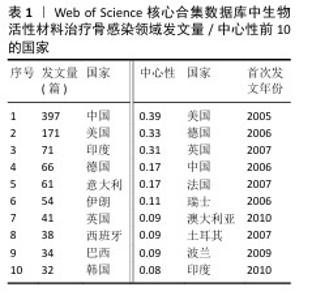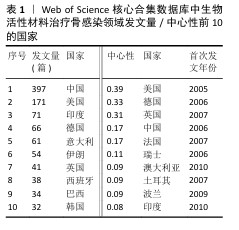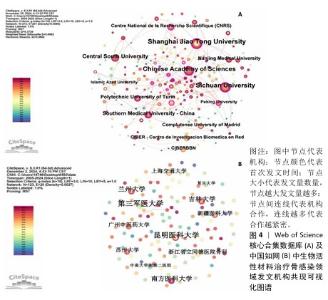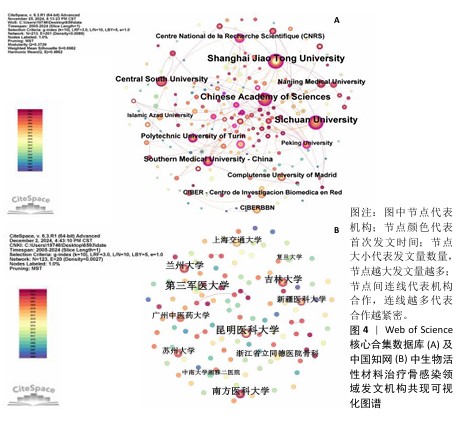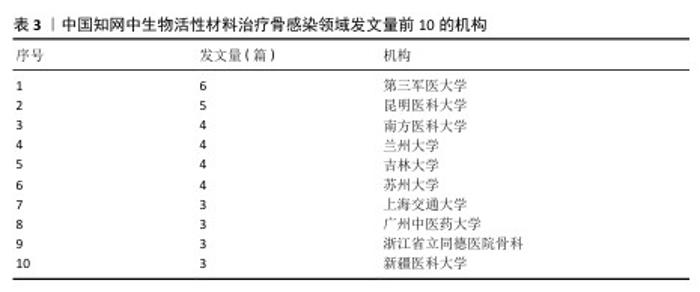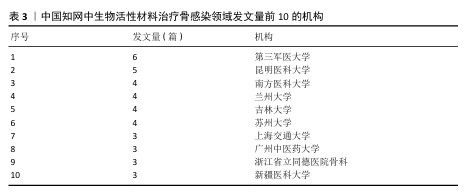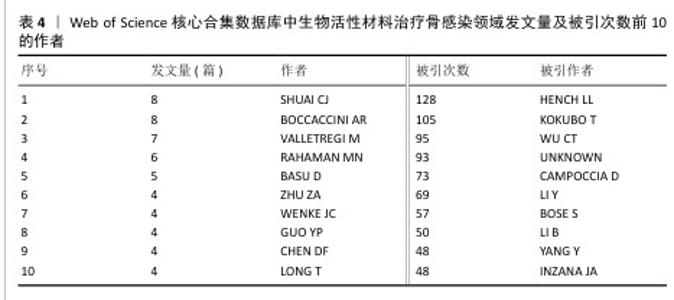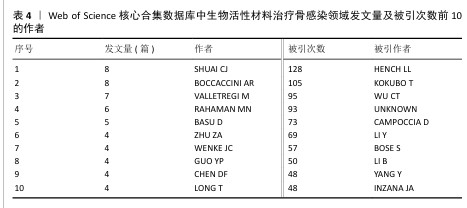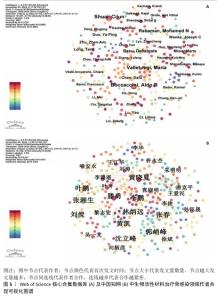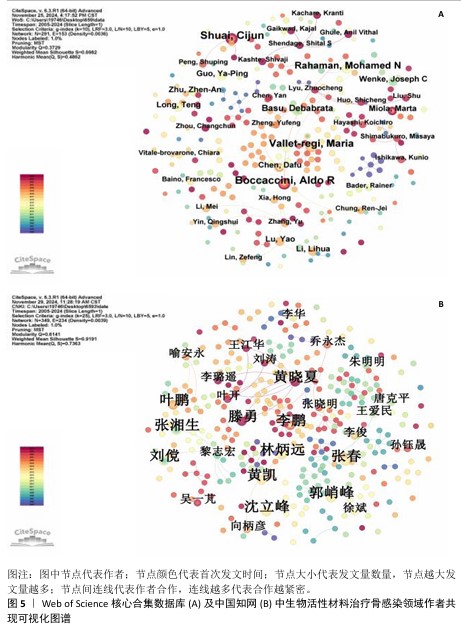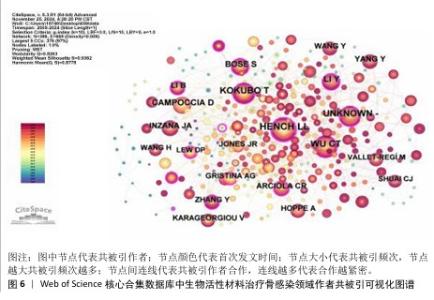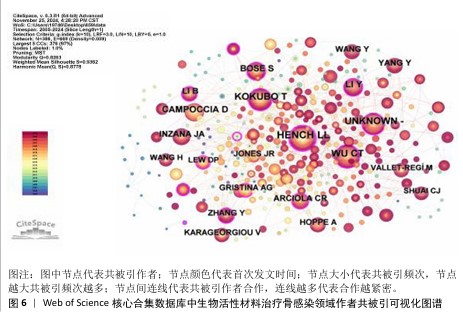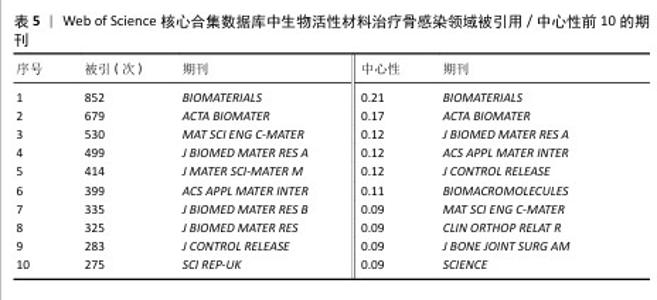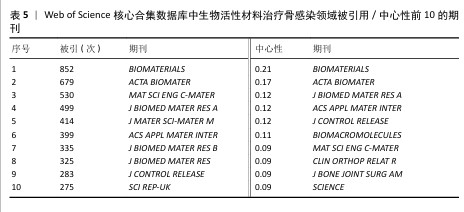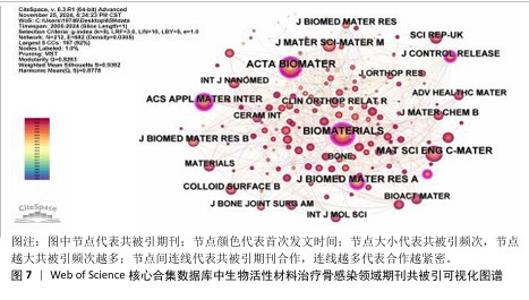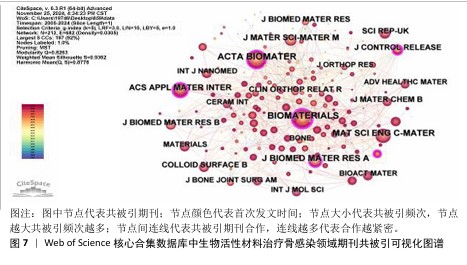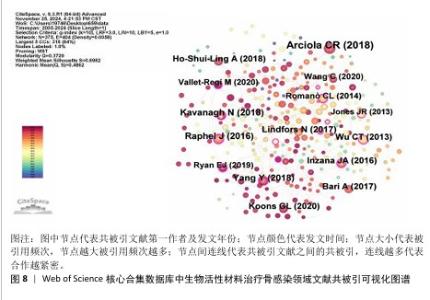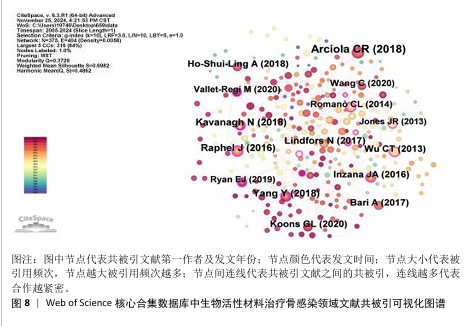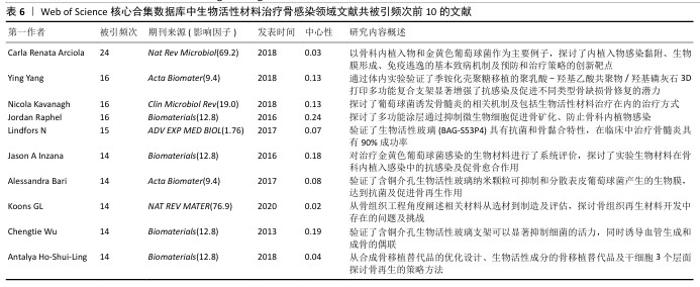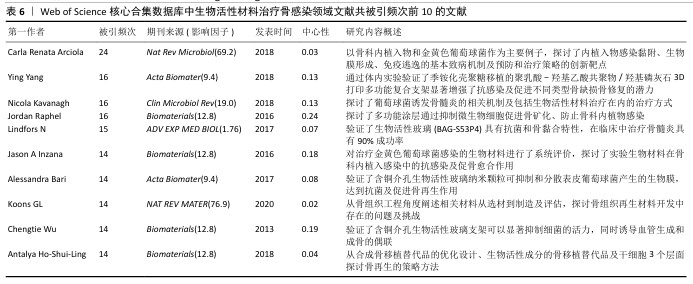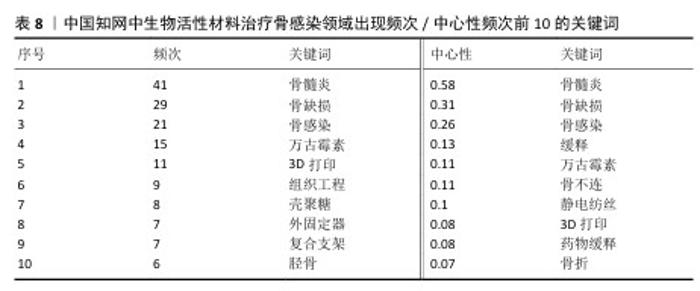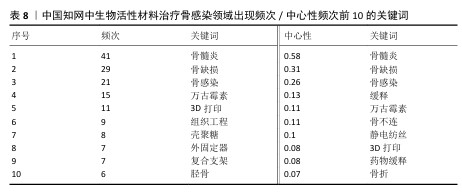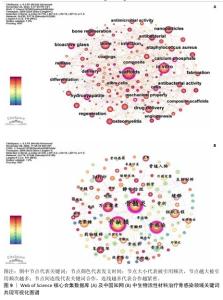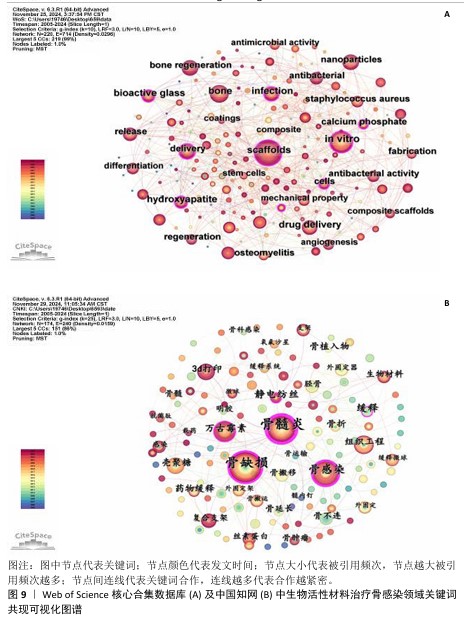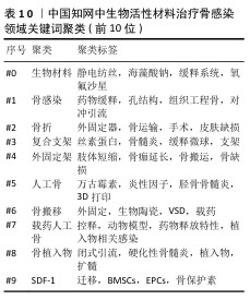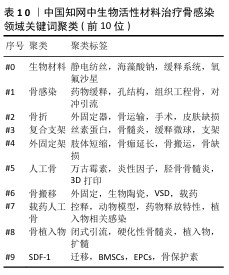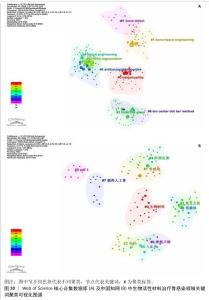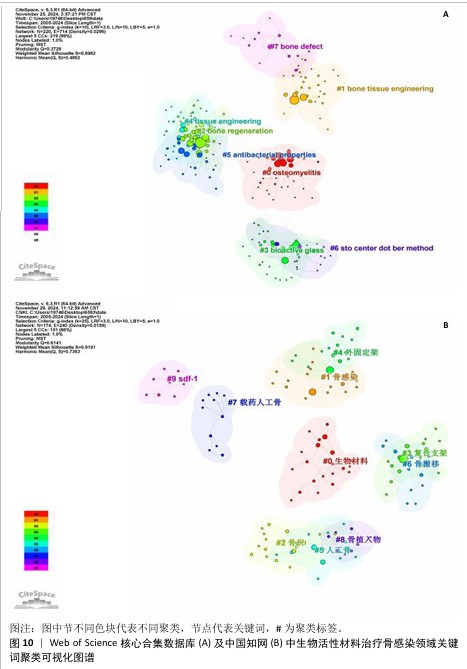Chinese Journal of Tissue Engineering Research ›› 2026, Vol. 30 ›› Issue (8): 2132-2144.doi: 10.12307/2026.049
Research hotspots and frontier trends of bioactive materials in treating bone infections
Lai Yu1, Chen Yueping2, Zhang Xiaoyun2
- 1Guangxi University of Chinese Medicine, Nanning 530001, Guangxi Zhuang Autonomous Region, China; 2Ruikang Hospital, Guangxi University of Chinese Medicine, Nanning 530001, Guangxi Zhuang Autonomous Region, China
-
Received:2024-12-25Accepted:2025-03-17Online:2026-03-18Published:2025-07-29 -
Contact:Chen Yueping, PhD, Chief physician, Doctoral supervisor, Ruikang Hospital, Guangxi University of Chinese Medicine, Nanning 530001, Guangxi Zhuang Autonomous Region, China -
About author:Lai Yu, Doctoral candidate, Physician, Guangxi University of Chinese Medicine, Nanning 530001, Guangxi Zhuang Autonomous Region, China -
Supported by:Key Clinical Specialty (Trauma Surgery) Construction Project of Guangxi Zhuang Autonomous Region, No. Guiweiyifa[2021]17 (to CYP); Category A “Guangxi School of Traditional Chinese Medicine Inheritance and Innovation Team” Project of Guangxi University of Chinese Medicine, No. 2022A004 (to CYP); Graduate Education Innovation Program of Guangxi University of Chinese Medicine, No. YCBXJ2023025 (to LY)
CLC Number:
Cite this article
Lai Yu, Chen Yueping, Zhang Xiaoyun. Research hotspots and frontier trends of bioactive materials in treating bone infections[J]. Chinese Journal of Tissue Engineering Research, 2026, 30(8): 2132-2144.
share this article
Add to citation manager EndNote|Reference Manager|ProCite|BibTeX|RefWorks
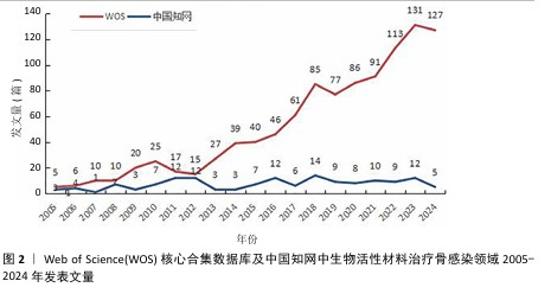
2.1 生物活性材料治疗骨感染领域发文量分析 通过对Web of Science核心合集数据库进行文献分析,发现生物活性材料治疗骨感染领域在近20年累计发表1 031篇相关文献,2005年文献发表最少(5篇),2023年文献发表最多(131篇)。从年度发文趋势分析,该领域自2012年起发文量呈现逐年上升趋势,这表明生物活性材料在骨感染领域的关注度不断提高,成为研究热点。另外,通过对中国知网数据库进行文献分析,显示过去20年间该领域共计发表149篇相关文献,其中2007年文献发表最少(1篇),2018年文献发表最多(14篇)。结合年度发文趋势发现,该领域相关文献发表于2018年达到峰值,至2024年发文量维持在稳定状态,这表明该领域研究在国内具有持续热度(图2)。2个数据库发文量存在较大差异考虑与中国学者也于Web of Science核心合集数据库发表大量文献有关。逐年持续上升的发文量考虑与经济、社会因素及大量建筑工程和交通设施的快速发展等外部因素对骨感染发生率的潜在影响相关,这些因素可能导致创伤性骨折、手术频繁及抗生素使用量的增加,从而推动了骨感染的研究热度。 "
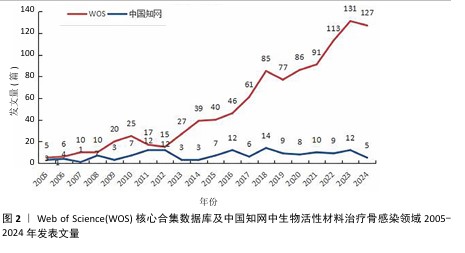
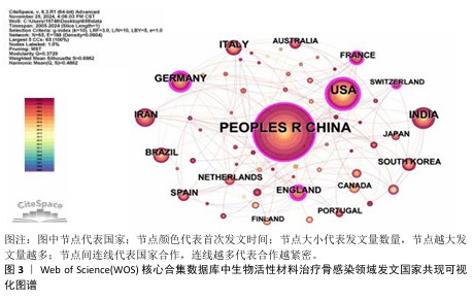
2.2 生物活性材料治疗骨感染领域发文国家分析 通过对Web of Science核心合集数据库中发文国家共现分析发现,近20年间发文量最多的国家是中国,2006年发文至今已达397篇,其次是美国,2005年发文至今已达171篇,见图3。从CiteSpace软件分析中发现,网络中心性最高的是美国(0.39),其次是德国(0.33),第三是英国(0.31),中国与法国并列第四(0.17)。结合发文量与中心性分析可得,美国是发文较早、发文量较大、中心性较高的国家,在该领域的研究中处于顶尖水平,而中国发文时间较美国稍晚,发文量却超越美国,说明中国在该领域的研究也处于高热度阶段,但中心性较前3国家稍显不足,说明中国在研究水平上较顶尖国家存在差距;其余国家如德国、英国虽发文量不大,但中心性较高,说明其他国家对于该领域也做出一定贡献,见表1。 "
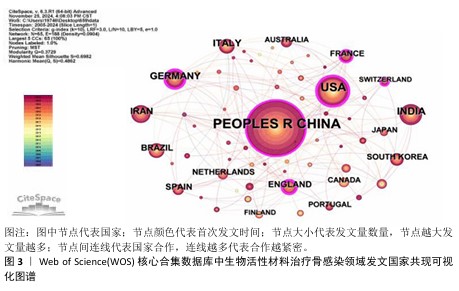
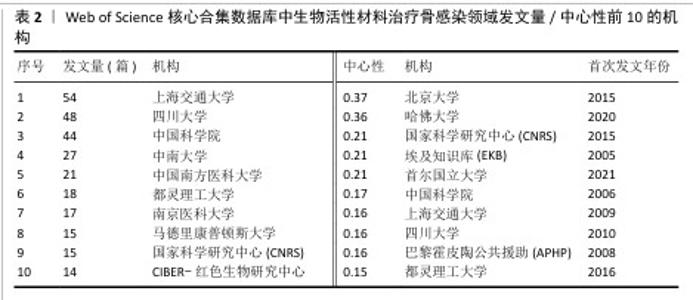
2.3 生物活性材料治疗骨感染领域发文机构分析 通过对Web of Science核心合集数据库中发文机构分析发现,在该领域发文前3的机构依次为上海交通大学(54篇)、四川大学(48篇)、中国科学院(44篇);根据计算得出网络中心性最高的为北京大学(0.37),其次为哈佛大学(0.36),见表2,图4。综合研究表明,北京大学与哈佛大学发文量较少,但中心性高,形成了紧密的学术联系,中国机构发文量大,但在学术合作网的构建上存在局限。 通过对中国知网中发文机构分析可以发现,发文量最大的机构为第三军医大学(6篇),其次为昆明医科大学(5篇),但中心性均为0,见表3,图4。综合研究表明,中国上述机构中心性低,学术合作联系不足。 2.4 生物活性材料治疗骨感染领域作者共现及共被引分析 通过对Web of Science核心合集数据库及中国知网中发文作者分析发现,发表文献最多的作者为SHUAI CJ与BOCCACCINI AR,而中文发表文献最多的作者为张湘生(4篇),见表4,图5。在被引用方面,被引次数最多的作者为HENCH LL(128次),并且中心性也为最高(0.34),其次为KOKUBO T(105次)以及WU CT(95次),见图6。 "
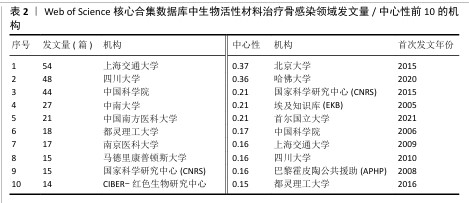
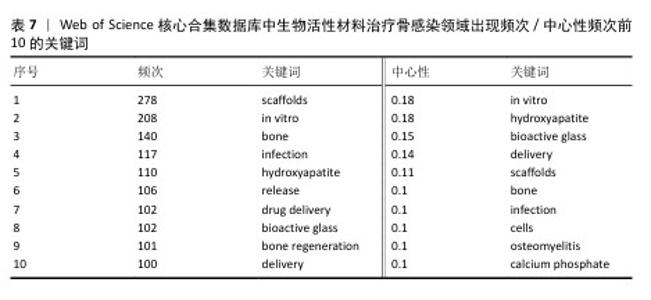
2.7 生物活性材料治疗骨感染领域关键词分析 2.7.1 生物活性材料治疗骨感染领域关键词共现分析 关键词共现分析通过统计文献中高频关键词的关联,能够揭示该研究领域的热点、研究主题及其内在联系。通过对Web of Science核心合集数据库中数据分析可得,scaffolds为频率最高的关键词(278次),其次为in vitro(208次),第三为bone(140次),其余前10关键词分别为infection、hydroxyapatite、release drug delivery、bioactive glass、bone regeneration、delivery。从中心性角度分析可知,in vitro及hydroxyapatite的中心性最高(0.18),其次为bioactive glass(0.15),见表7,图9。对中国知网中的相关文献进行分析发现,骨髓炎出现频率最高(41次),其次为骨缺损(29次)与骨感染(21次),而中心性分析前3也为骨髓炎(0.58)、骨缺损(0.31)和骨感染(0.26),见表8,图9。 综合分析可以发现,在去除疾病本身直接关键词后,英文核心关键词主要为支架及羟基磷灰石、生物活性玻璃等生物活性材料,而中文则为万古霉素、药物缓释、静电纺丝、3D打印等搭载技术。以此分析可以发现,外文文献在该领域侧重于对于新材料的研发与应用,国内文献侧重于药物搭载进行治疗。 "
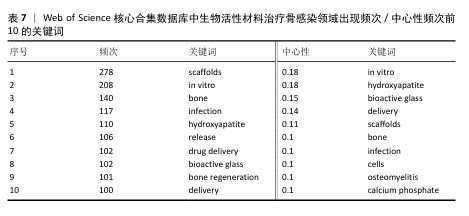
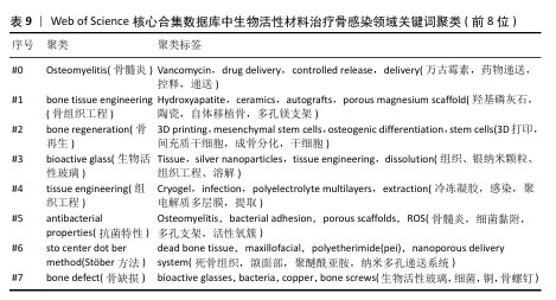
2.7.2 生物活性材料治疗骨感染领域关键词聚类分析 关键词聚类分析是通过计量学工具对关键词进行聚类,以揭示研究热点和主题间的关系。通过对Web of Science核心合集数据库中数据分析可得Q=0.372 9、S=0.698 2,显示聚类结构显著、结果合理,选取前8位的关键词聚类,见图10。#0为osteomyelitis,主要反映药物递送与控制释放在骨髓炎治疗中的应用;#1为bone tissue engineering,反映了骨组织工程技术在骨感染治疗中的核心地位,尤其是材料的研究成为突破点;#2为bone regeneration,主要反映骨再生技术与干细胞的结合应用,推动材料与生物技术的结合;#3为bioactive glass,反映了其在组织工程和感染相关治疗中的应用前景;#4为tissue engineering,反映了组织工程在感染防治与材料应用中的研究;#5为antibacterial properties,反映抗菌特性与骨感染相关材料研究;#6为sto center dot ber method,主要反映新型材料和方法在骨感染治疗中的应用研究;#7起bone defect,主要反映骨缺损修复中的生物活性材料与抗菌策略研究,见表9。 通过对中国知网中的文献分析可得Q=0.614 1、S=0.919 1,显示聚类结构合理、可信度高,选取前10位的聚类,见图10。#0为生物材料,反映生物材料结合缓释系统在骨感染中应用;#1为骨感染,反映骨感染治疗中药物缓释与组织工程技术的融合应用;#2为骨折,反映骨折治疗中外固定技术与骨运输策略的应用;#3为复合支架,反映复合支架在骨感染治疗中的应用;#4为外固定架,反映外固定架在骨缺损及相关治疗中的应用;#5为人工骨,反映人工骨在骨感染治疗中的应用;#6为骨搬移,反映骨搬移技术与新型材料在骨缺损修复中的应用;#7为载药人工骨,反映载药人工骨在骨感染治疗中的应用与研究;#8为骨植入物,反映骨植入物相关治疗与骨髓炎研究;#9为SDF-1,反映SDF-1在骨组织修复中的作用,见表10。 "
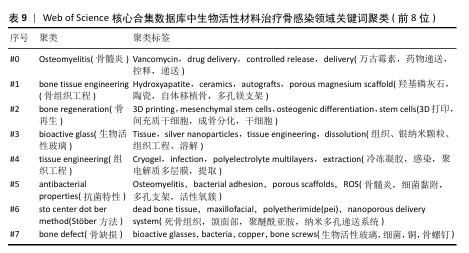
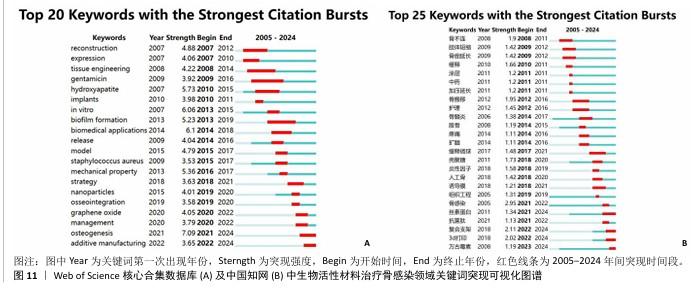
2.7.3 生物活性材料治疗骨感染领域关键词突现分析 关键词突现分析是用于揭示在某一特定时间段内某些关键词、术语或概念的研究热度突升的方法。通过对Web of Science核心合集数据库中数据分析得出前20位突现词,见图11。其中,Biomedical Applications强度最高,说明了生物材料和技术在该领域中的广泛应用;而在骨修复重建植入物中,Hydroxyapatite 在2007年开始研究,在2010-2015年形成强突现;随着研究深入,Graphene Oxide在2020年被发掘研究,并在2020-2022年形成强突现,显示着对材料选择上的更迭及深入研究;在抗菌方面,Biofilm Formation在2013-2019年形成强突现,这考虑为在2010年代后对生物膜的基因组学和蛋白质组学研究进入快速发展引起。 通过对中国知网中的数据分析得出前25位突现词,见图11。其中,早期主要为骨修复与骨缺损相关起步研究,中期则为骨感染和组织工程研究的兴起,而3D打印与复合支架在2022-2024年形成强突现,显示着它是近年来的热门研究。"
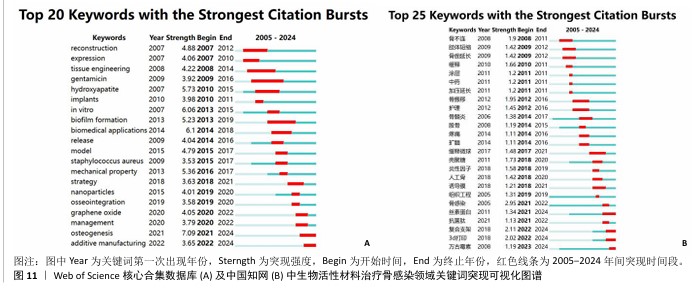
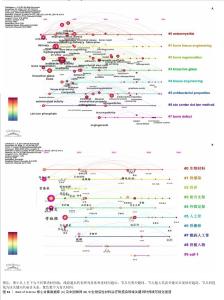
2.7.4 生物活性材料治疗骨感染领域关键词时间线分析 关键词时间线分析是用于揭示研究主题的演变过程和前沿热点,了解研究领域的发展脉络和未来方向的分析方法。通过对Web of Science核心合集数据库中数据分析得出,早期以release、hydroxyapatite、 bone regeneration等为关键词,反映早期对控释与骨再生研究的重视,而近期则为composite scaffolds、3D printing、nanoparticles等为关键词,说明研究趋势向新兴技术如3D打印、复合支架、纳米材料发展。从聚类主题演变发现骨髓炎始终贯穿时间线,组织工程则为重要持续主题,而抗菌性能则是新型研究,见图12。通过对中国知网中的数据分析得出,生物材料贯穿整个时间段,研究逐渐深化,涵盖基础研究到临床应用,而骨搬移在2016年后逐渐被新兴热点如复合支架与3D打印所取代,说明该领域的研究逐渐向多学科交叉发展趋势,见图12。"
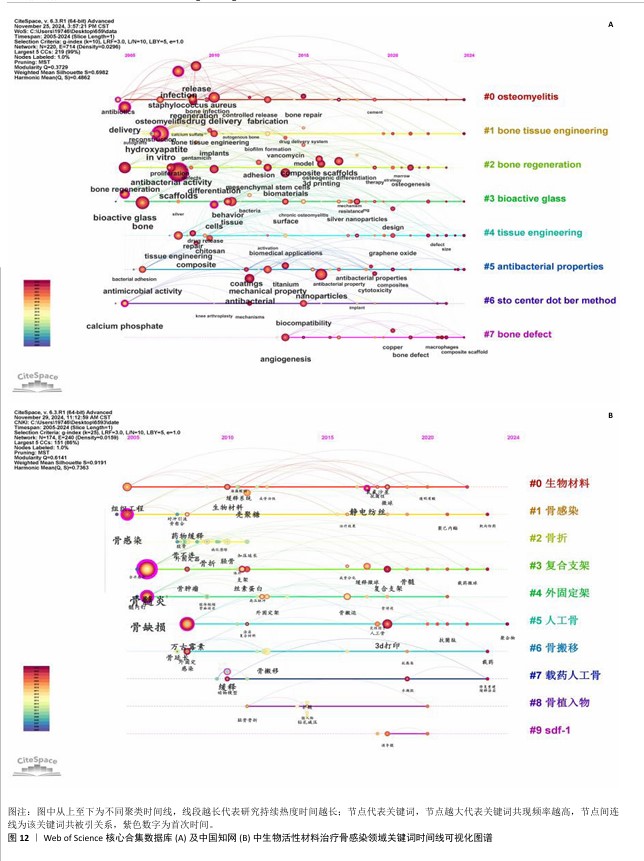
| [1] JENSEN LK, HARTMANN KT, WITZMANN F, et al. Bone infection evolution. Injury. 2024; 55 Suppl 6:111826. [2] 吴永军,赵猛.感染性骨缺损的治疗现状[J].生物骨科材料与临床研究,2022, 19(4):86-90. [3] TANG RH, YANG J, FEI J. New perspectives on traumatic bone infections. Chin J Traumatol. 2020;23(6):314-318. [4] WILLIAMS DF. Biocompatibility pathways and mechanisms for bioactive materials: The bioactivity zone. Bioact Mater. 2021;26(10):306-322. [5] WANG G, CUI Y, LIU H, et al. Antibacterial peptides-loaded bioactive materials for the treatment of bone infection. Colloids Surf B Biointerfaces. 2023;225:113255. [6] NINKOV A, FRANK JR, MAGGIO LA. Bibliometrics: Methods for studying academic publishing. Perspect Med Educ. 2022;11(3):173-176. [7] ARCIOLA CR, CAMPOCCIA D, MONTANARO L. Implant infections: adhesion, biofilm formation and immune evasion. Nat Rev Microbiol. 2018;16(7):397-409. [8] YANG Y, CHU L, YANG S, et al. Dual-functional 3D-printed composite scaffold for inhibiting bacterial infection and promoting bone regeneration in infected bone defect models. Acta Biomater. 2018;1(79):265-275. [9] KAVANAGH N, RYAN EJ, WIDAA A, et al. Staphylococcal Osteomyelitis: Disease Progression, Treatment Challenges, and Future Directions. Clin Microbiol Rev. 2018; 31(2):e00084-17. [10] RAPHEL J, HOLODNIY M, GOODMAN SB, et al. Multifunctional coatings to simultaneously promote osseointegration and prevent infection of orthopaedic implants. Biomaterials. 2016;84:301-314. [11] LINDFORS N, GEURTS J, DRAGO L, et al. Antibacterial Bioactive Glass, S53P4, for Chronic Bone Infections - A Multinational Study. Adv Exp Med Biol. 2017;971:81-92. [12] INZANA JA, SCHWARZ EM, KATES SL, et al. Biomaterials approaches to treating implant-associated osteomyelitis. Biomaterials. 2016;81:58-71. [13] BARI A, BLOISE N, FIORILLI S, et al. Copper-containing mesoporous bioactive glass nanoparticles as multifunctional agent for bone regeneration. Acta Biomater. 2017;55:493-504. [14] WU C, ZHOU Y, XU M, et al. Copper-containing mesoporous bioactive glass scaffolds with multifunctional properties of angiogenesis capacity, osteostimulation and antibacterial activity. Biomaterials. 2013;34(2):422-433. [15] HO-SHUI-LING A, BOLANDER J, RUSTOM LE, et al. Bone regeneration strategies: Engineered scaffolds, bioactive molecules and stem cells current stage and future perspectives. Biomaterials. 2018;180:143-162. [16] CHEN ZY, GAO S, ZHANG YW, et al. Antibacterial biomaterials in bone tissue engineering. J Mater Chem B. 2021;9(11): 2594-2612. [17] XIE H, LIU Y, AN H, et al. Recent advances in prevention, detection and treatment in prosthetic joint infections of bioactive materials. Front Bioeng Biotechnol. 2022; 10:1053399. [18] WANG J, LIU M, YANG C, et al. Biomaterials for bone defect repair: Types, mechanisms and effects. Int J Artif Organs. 2024;47(2):75-84. [19] ALMULHIM KS, SYED MR, ALQAHTANI N, et al. Bioactive Inorganic Materials for Dental Applications: A Narrative Review. Materials (Basel). 2022;15(19):6864. [20] Islam MM, Shahruzzaman M, Biswas S, et.al. Chitosan based bioactive materials in tissue engineering applications-A review. Bioact Mater. 2020;5(1):164-183. [21] VALENCIA ZAPATA ME, MINA HERNANDEZ JH, GRANDE TOVAR CD, et al. Novel Bioactive and Antibacterial Acrylic Bone Cement Nanocomposites Modified with Graphene Oxide and Chitosan. Int J Mol Sci. 2019;20(12):2938. [22] RATHER MA, GUPTA K, MANDAL M. Microbial biofilm: formation, architecture, antibiotic resistance, and control strategies. Braz J Microbiol. 2021;52(4):1701-1718. [23] LV X, WANG L, MEI A, et al. Recent Nanotechnologies to Overcome the Bacterial Biofilm Matrix Barriers. Small. 2023;19(6):e2206220. [24] GHOLAP AD, ROJEKAR S, KAPARE HS, et al. Chitosan scaffolds: Expanding horizons in biomedical applications. Carbohydr Polym. 2024;323:121394. [25] JIN Y, LIU H, CHU L, et al. Initial therapeutic evidence of a borosilicate bioactive glass (BSG) and Fe3O4 magnetic nanoparticle scaffold on implant-associated Staphylococcal aureus bone infection. Bioact Mater. 2024; 8(40):148-167. [26] FAN F, LIU Y, LIU Y, et al. Candida albicans biofilms: antifungal resistance, immune evasion, and emerging therapeutic strategies. Int J Antimicrob Agents. 2022; 60(5-6):106673. [27] AMNA T, HASSAN MS. Nanofibers and Nanotextured Materials: Design Insights, Bactericidal Mechanisms and Environmental Advances. Nanomaterials (Basel). 2023; 13(21):2891. [28] 王兆飞,何国云,田方灿,等.活性屏等离子表面改性技术制备纳米银涂层不锈钢的体外抗菌性能[J].中国组织工程研究,2024,28(22):3464-3471. [29] FRANCO D, CALABRESE G, GUGLIELMINO SPP, et al. Metal-Based Nanoparticles: Antibacterial Mechanisms and Biomedical Application. Microorganisms. 2022;10(9): 1778. [30] XU L, FANG J, PAN J, et al. Zinc finger-inspired peptide-metal-phenolic nanointerface enhances bone-implant integration under bacterial infection microenvironment through immune modulation and osteogenesis promotion. Bioact Mater. 2024;41:564-576. [31] LI Z, ZHAO Y, WANG Z, et al. Engineering Multifunctional Hydrogel-Integrated 3D Printed Bioactive Prosthetic Interfaces for Osteoporotic Osseointegration. Adv Healthc Mater. 2022;11(11):e2102535. [32] GOVONI M, LAMPARELLI EP, CIARDULLI MC, et al. Demineralized bone matrix paste formulated with biomimetic PLGA microcarriers for the vancomycin hydrochloride controlled delivery: Release profile, citotoxicity and efficacy against S. aureus. Int J Pharm. 2020;582:119322. [33] MOGHANIAN A, PORTILLO-LARA R, SHIRZAEI SANI E, et al. Synthesis and characterization of osteoinductive visible light-activated adhesive composites with antimicrobial properties. J Tissue Eng Regen Med. 2020; 14(1):66-81. [34] ZHAO Y, LI J, LIU L, et al. Zinc-Based Tannin-Modified Composite Microparticulate Scaffolds with Balanced Antimicrobial Activity and Osteogenesis for Infected Bone Defect Repair. Adv Healthc Mater. 2023;12(20): e2300303. [35] QIAN H, LEI T, HUA L, et al. Fabrication, bacteriostasis and osteointegration properties researches of the additively-manufactured porous tantalum scaffolds loading vancomycin. Bioact Mater. 2023; (24):450-462. [36] HUANG H, QIANG L, FAN M, et al. 3D-printed tri-element-doped hydroxyapatite/ polycaprolactone composite scaffolds with antibacterial potential for osteosarcoma therapy and bone regeneration. Bioact Mater. 2023; 4(31):18-37. [37] CÁMARA-TORRES M, DUARTE S, SINHA R, et al. 3D additive manufactured composite scaffolds with antibiotic-loaded lamellar fillers for bone infection prevention and tissue regeneration. Bioact Mater. 2020; 6(4):1073-1082. [38] MAKSOUD FJ, VELÁZQUEZ DE LA PAZ MF, HANN AJ, et al. Porous biomaterials for tissue engineering: a review. J Mater Chem B. 2022;10(40):8111-8165. [39] QI J, YU T, HU B, et al. Current Biomaterial-Based Bone Tissue Engineering and Translational Medicine. Int J Mol Sci. 2021; 22(19):10233. [40] CARVALHO MS, SILVA JC, UDANGAWA RN, et al. Co-culture cell-derived extracellular matrix loaded electrospun microfibrous scaffolds for bone tissue engineering. Mater Sci Eng C. 2019;99:479. [41] LEE J, HUH SJ, SEOK JM, et al. Surface engineering of 3D-printed scaffolds with minerals and a pro-angiogenic factor for vascularized bone regeneration. Acta Biomater. 2022;140(3):730-744. [42] KUMAR DEWANGAN V, SAMPATH KUMAR TS, DOBLE M, et al. Fabrication of injectable antibiotic-loaded apatitic bone cements with prolonged drug delivery for treating post-surgery infections. J Biomed Mater Res A. 2023;111(11):1750-1767. [43] 龙琳,朱琳,汤惠茗,等.金属纳米材料对细菌耐药的影响及其机制研究进展[J].中国环境科学,202545(5):2857-2864. [44] ZENG J, GU C, GENG X, et al. Combined photothermal and sonodynamic therapy using a 2D black phosphorus nanosheets loaded coating for efficient bacterial inhibition and bone-implant integration. Biomaterials. 2023;297:122122. [45] ZHANG X, LI Q, LI L, et al. Bioinspired Mild Photothermal Effect-Reinforced Multifunctional Fiber Scaffolds Promote Bone Regeneration. ACS Nano. 2023;17(7): 6466-6479. [46] ZHANG J, YE X, LI W, et al. Copper-containing chitosan-based hydrogels enabled 3D-printed scaffolds to accelerate bone repair and eliminate MRSA-related infection. Int J Biol Macromol. 2023;(240):124463. [47] SCHWARTZMAN JD, MCCALL M, GHATTAS Y, et al. Multifunctional scaffolds for bone repair following age-related biological decline: Promising prospects for smart biomaterial-driven technologies. Biomaterials. 2024;311:122683. [48] HAGEMAN KA, BLATT RL, KUENNE WA, et al. Effect of pH and hydroxyapatite-like layer formation on the antibacterial properties of borophosphate bioactive glass incorporated poly(methyl methacrylate) bone cement. Front Bioeng Biotechnol. 2024;18(12):1462795. |
| [1] | Liu Hongjie, Mu Qiuju, Shen Yuxue, Liang Fei, Zhu Lili. Metal organic framework/carboxymethyl chitosan-oxidized sodium alginate/platelet-rich plasma hydrogel promotes healing of diabetic infected wounds [J]. Chinese Journal of Tissue Engineering Research, 2026, 30(8): 1929-1939. |
| [2] | Wang Songpeng, Liu Yusan, Yu Huanying, Gao Xiaoli, Xu Yingjiang, Zhang Xiaoming, Liu Min. Bidirectional regulation of reactive oxygen species based on zeolitic imidazolate framework-8 nanomaterials: from tumor therapy and antibacterial activity to cytoprotection [J]. Chinese Journal of Tissue Engineering Research, 2026, 30(8): 2033-2013. |
| [3] | Wang Zhuo, Sun Panpan, Cheng Huanzhi, Cao Tingting. Application of chitosan in repair and regeneration of oral hard and soft tissues [J]. Chinese Journal of Tissue Engineering Research, 2026, 30(2): 459-468. |
| [4] | Wang Yu, Fan Minjie, Zheng Pengfei. Application of multistimuli-responsive hydrogels in bone damage repair: special responsiveness and diverse functions [J]. Chinese Journal of Tissue Engineering Research, 2026, 30(2): 469-479. |
| [5] | Yan Qiquan, Yang Libin, Li Mengjun, Ni Yazhuo, Chen Keying, Xu Bo, Li Yaoyang, Ma Shiqing, Li Rui, Li Jianwen. Preparation and antibacterial properties of porcine small intestinal submucosal composite nanohydroxyapatite bioscaffold loaded with antimicrobial peptide KR-12-a5 [J]. Chinese Journal of Tissue Engineering Research, 2026, 30(2): 384-394. |
| [6] | Yuan Qian, Zhang Hao, Pang Jie. Characterization and biological properties of naringin-loaded chitosan/beta-tricalcium phosphate scaffold [J]. Chinese Journal of Tissue Engineering Research, 2026, 30(2): 424-432. |
| [7] | Huang Xinxu, Zhang Xin, Wang Jian. Living microecological hydrogels promote skin wound healing [J]. Chinese Journal of Tissue Engineering Research, 2026, 30(2): 489-498. |
| [8] | Xu Wenhe, Li Xiaobing, Liu Fang. Functionalized biomimetic mineralized collagen modified orthopedic implants [J]. Chinese Journal of Tissue Engineering Research, 2026, 30(2): 516-527. |
| Viewed | ||||||
|
Full text |
|
|||||
|
Abstract |
|
|||||
